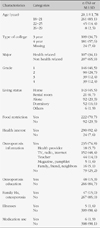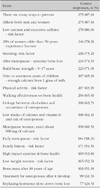Abstract
Purpose
The purpose of this study was to investigate osteoporosis knowledge, health beliefs, and influencing factors on health behaviors among female college students.
Methods
Using the Osteoporosis Quiz, the Health belief Scale, and the Health Behavior Questionnaire, data were collected from 314 female college students from 4 universities located in Chungcheong providence.
Results
The mean scores of knowledge and health belief were 12.7±3.81 and 90.9±12.66, respectively. There was a statistically significant correlation between osteoporosis knowledge and health belief (p<.001). Also, a statistically significant correlation was found between health belief and health behavior (p<.001). According to the regression model, knowledge, perceived benefit, perceived barrier, family history of osteoporosis, and health interest explained 6.7% of total variance in health behavior.
Figures and Tables
References
1. Ailinger RL, Lasus H, Braun MA. Revision of the facts on osteoporosis quiz. Nurs Res. 2003; 52(3):198–201.

2. Caudarella R, Vescini F, Rizzoli E, Francucci CM. Salt intake, hypertension, and osteoporosis. J Endocrinol Invest. 2009; 32:4 Suppl. 15–20.
3. Chung M, Hwang K, Choi E. Study of the level of osteoporosis awareness among women dwelling in urban area. Korean J Women Health Nurs. 2009; 15(4):362–371.

4. Ford MA, Bass MA, Keathley R. Osteoporosis knowledge and attitudes: A cross sectional study among college-age students. J Am Coll Health. 2007; 56(1):43–47.
5. Han SM. Health promotion behaviors of the diets and exercises to prevent osteoporosis in college students. Korean J Exerc Nutr. 2006; 10(2):89–98.
6. Kim KK, Horan ML, Gendler P, Patel MK. Development and evaluation of the osteoporosis health belief scale. Res Nurs Health. 1991; 14:155–163.

7. Kim HK. Factors influencing health promoting behaviors of university students using pender's model. Korean J Women Health Nurs. 2006; 12(2):132–141.

8. Kim YM, Kim MH. A study of the osteoporosis related life style and health promotion behavior of university and college female student. J Rheumatol Health. 2002; 9(1):53–67.
9. Korean Society of Bone Metabolism. Physician's Guideline for Osteoporosis. Seoul: Seoul Publishing;2007.
10. Lee BS, Kim MY, Kim MH, Kim SK. Health belief and performance of health behaviors of some university students in Korea. J Korean Acad Nurs. 2000; 30(1):213–224.

11. Lim JH, Bae HS, Lee SM, Ahn HS. Dietary and non-dietary factors related to bone mineral density in female college students. Korean J Community Nutr. 2008; 13(3):418–425.
12. Lee JH, Kim EJ, Suk MH, Kim EY, Hwang LI. Factors influencing osteoporosis. J Korean Community Nurs. 2003; 14(2):253–262.
13. Ministry of Health & Welfare. 2001 National health and nutrition survey - Chronic disease. 2002. Retrieved August 10, 2009. http://knhanes.cdc.go.kr.
14. Moon ES, Lee ES. The Relationship between Knowledge, Health Beliefs, and Prevention Behaviors of Osteoporotic Fracture in Patients receiving Osteoporosis Treatment. Korean J Women Health Nurs. 2010; 16(2):147–156.

15. National Institute of Health. Osteoporosis prevention, diagnosis, and therapy: National institute of health consensus development conference statement. 2000. Retrieved March 8, 2009. from http://www.ncbi.nih.gov.books/NBK15108.
16. Oliver H, Jameson KA, Sayer AA, Cooper C, Dennison EM. Hertfordshire Cohort Study Group. Growth in early life predicts bone strength in late adulthood: The hertfordshire cohort study. Bone. 2007; 41(3):400–405.

17. Pender NJ. Expressing health through lifestyle patterns. Nurs Sci Q. 1990; 3:115–122.
18. Peterson BA, Klesges RC, Kaufman EM, Cooper TV, Vukadinovich CM. The effects of an educational intervention on calcium intake and bone mineral content in young women with low calcium intake. Am J Health Promot. 2000; 14(3):149–156.

19. Raisz LG. Local and systemic factors in the pathogenesis of osteoporosis. N Engl J Med. 1988; 318(13):818–828.

20. Ribeiro V, Blakeley JA. Evaluation of an osteoporosis workshop for women. Public Health Nurs. 2001; 18(3):186–193.

21. Rosenstock IM, Charles B. Historical origin of the health belief model: The health belief model and personal health behavior. Thorofare, New Jersey: sLAC, Inc;1974.
22. Shin KR, Kang YM. A study on the relationships between osteoporosis knowledge, self-efficacy and health belief of women in an island. J Korean Acad Nurs. 2002; 32(1):89–99.

23. Shin SJ, Shin KR, Yi HR, Ju SK. Knowledge, health belief, and self-efficacy related to osteoporosis. J Korean Acad Nurs. 2005; 35(5):850–857.

24. Song HR, So HY. Effects of the knowledge, health belief, and self-efficacy about osteoporosis on calcium intake behavior for postmenopausal osteoporosis patients. J Korean Acad Adult Nurs. 2007; 19(5):763–774.
25. Sun KS. The effect of web-based osteoporosis prevention program on the osteoporosis knowledge, self efficacy, health belief, stage of change in female college students. Gwangju: Chonnam National University;2003. Unpublished doctoral dissertation.
26. Sunwoo S, Kim YS, Cheon KS, Song SW, Choi Y, Koh HJ. Prevalence and risk factors of osteoporosis among Korean post menopausal women in primary care. Korean J Health Promot Dis Prev. 2003; 3(4):332–339.
27. Yoon EJ. The model explaining variance in health promoting behavior and quality of life in women with osteoporosis. Seoul: Kyung Hee University;2001. Unpublished doctoral dissertation.
28. Wallace LS. Osteoporosis prevention in college women: Application of the expanded health belief model. Am J Health Behav. 2002; 26(3):163–172.

29. Won IS. A study on osteoporosis knowledge, self-efficacy, health promoting behaviors and BMD among adult women. Daejeon: Eulji University;2009. Unpublished master's thesis.




 PDF
PDF ePub
ePub Citation
Citation Print
Print







 XML Download
XML Download